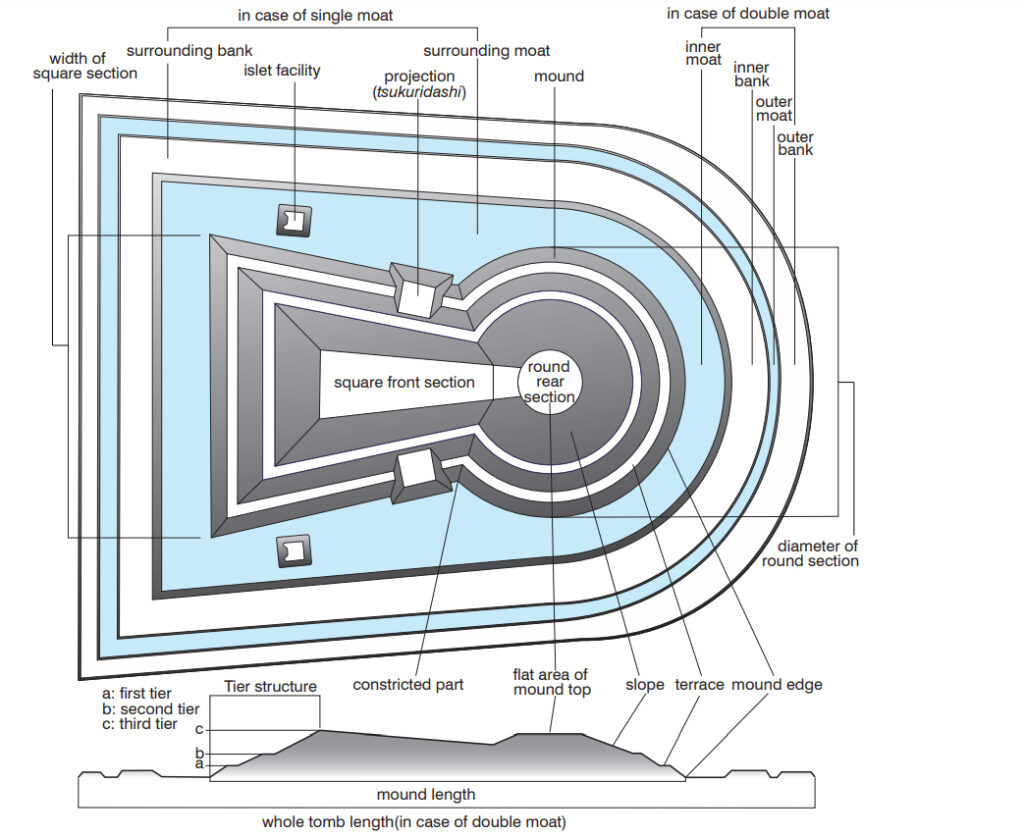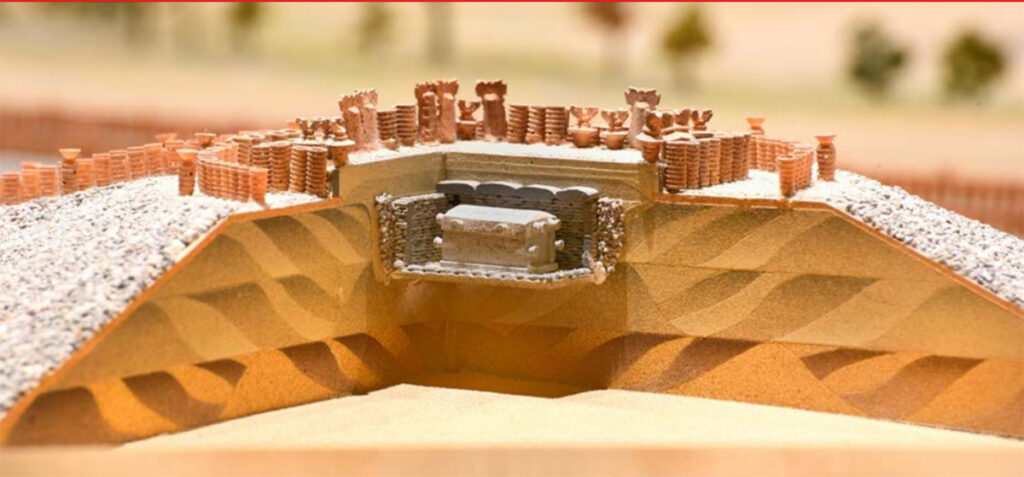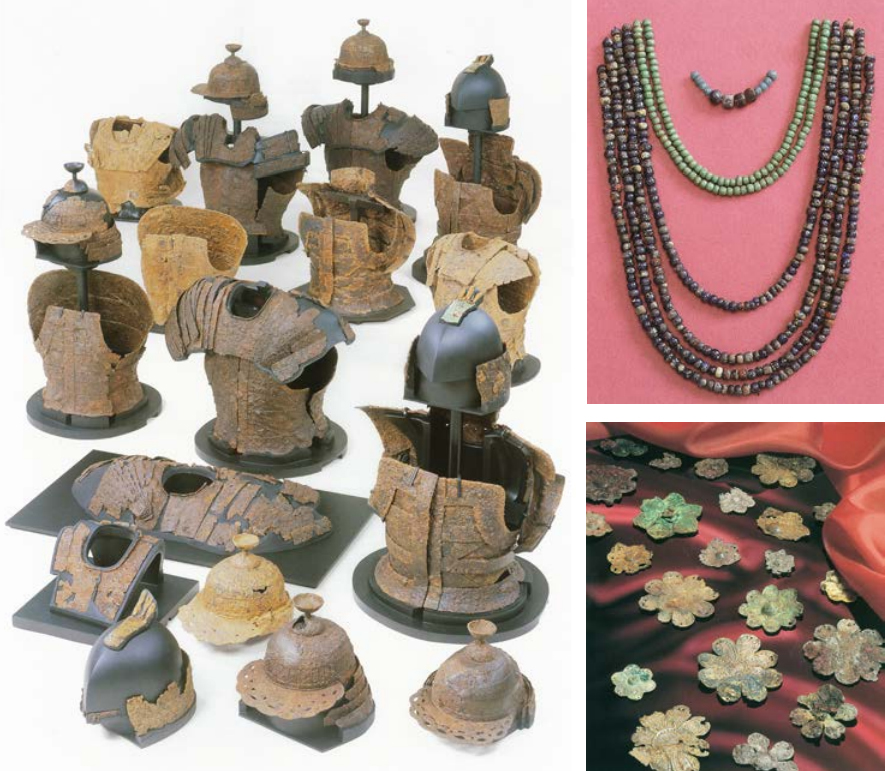កូហ្វុន (Kofun) គឺជាឈ្មោះ នៃសម័យកាលមួយក្នុងប្រវត្តិសាស្រ្តនៃប្រទេសជប៉ុន ដោយនៅក្នុងវេបសាយរបស់ Unesco បានកំណត់សម័យកាលកូហ្វុន គឺចាប់ពីស.វ.ទី៣ រហូតដល់ស.វ.ទី៦នៃគ.ស. ដែលមានផ្នូរចំនួនជាង ១៦០០០០ ប៉ុន្តែនៅក្នុងវេបសាយរបស់សារមន្ទីរ Metropolitan បានកំណត់ចាប់ ពីស.វ.ទី៤ ដល់ស.វ.ទី ៨នៃគ.ស. ពោលគឺចាប់ពីឆ្នាំ ៣០០ នៃគ.ស. រហូតដល់ឆ្នាំ ៧១០នៃគ.ស.។ ចំពោះឈ្មោះកូហ្វុន គឺមានន័យថា ជាភ្នំចាស់នៅក្នុងភាសាជប៉ុន ដោយសំដៅលើផ្នូរដែលជាកន្លែងកប់សពសម្រាប់វណ្ណៈ អភិជននៅអំឡុងសម័យកាលនោះ ដោយនៅចុងស.វ.ទី៤ រហូតដល់ស.វ.ទី៥នៃគ.ស. ការកសាងផ្នូរកូហ្វុន គឺមានការកើនឡើងជាខ្លាំងដែលជាការបង្ហាញអំពីការរីកចម្រើននៃការគ្រប់គ្រងក្នុងសម័យកូហ្វុននេះ និងជាសម័យកាលមុនពេលដែលមានឥទ្ឋិពលចិនចូលក្នុងប្រទេសជប៉ុន។ នៅចុងស.វ.ទី ៥ អំណាចនយោបាយត្រូវបានគ្រប់គ្រងដោយត្រកូល យ៉ាម៉ាតូ (Yamato) ដែលបានគ្រប់គ្រងលើកោះ ហុនស៊ូ (Honshū) និងពាក់កណ្តាលភាគខាងជើងនៃតំបន់គីយូស៊ូ (Kyūshū) ហើយបន្តបន្ទាប់មកបានបង្កើតអាណាចក្រក្នុង ប្រទេសជប៉ុន។

ប្រភព៖ https://www.bunka.go.jp
ស្ថានីយបុរាណវិទ្យា Mozu-Furuichi Kofun Group គឺជាបណ្តុំនៃផ្នូរជាច្រើនក្នុងសម័យកាលកូហ្វុន ដោយមាន៤៩ផ្នូរដែលស្ថិតនៅតំបន់ Mozu និង Furuichi ស្ថិតនៅផ្នែកខាងលើនៅតំបន់ខ្ពង់រាប អូសាកា។ ចំពោះទីតាំងនេះ គឺជាតំបន់មជ្ឈមណ្ឌលនយោបាយ វប្បធម៌ដ៏សំខាន់ នៃប្រជុំកោះជប៉ុននាសម័យបុរាណ (Ancient Japanese archipelago)។ស្ថានីយបុរាណវិទ្យានេះ ត្រូវបានចូលក្នុងបញ្ជីបេតិកភណ្ឌពិភពលោកនៅក្នុងឆ្នាំ២០១៩ ដែលមានផ្ទៃដីសរុប ១៦៦.៦៦ ហិតា។

ប្រភព៖ https://www.bunka.go.jp
ចំពោះទីតាំងនៃសំណង់ផ្នូរកូហ្វុន នៅក្នុងតំបន់ ម៉ូហ្សូ (Mozu) និងហ្វូរូឈី (Furuichi) គឺបែងចែកមានពីរផ្នែក ដែលមួយស្ថិតនៅក្នុងតំបន់ ម៉ូហ្សូ (Mozu) ដែលបច្ចុប្បន្នជាទីក្រុងសាកៃ (Sakai) និងតំបន់ ហ្វូរូឈី (Furuichi) ដែលមានទីក្រុង ហាប៊ីគីណូ (Habikino) និង ទីក្រុង ហ្វីជីដេរ៉ា (Fujiidera)។
នៅក្នុងសម័យកាលកូហ្វុនដែលកសាងសំណង់ផ្នូរទាំងអស់នោះ បែងចែកជាបីសម័យកាល គឺសម័យដើមនៃកូហ្វុន ( ពាក់កណ្តាលស.វ.ទី៣ រហូតដល់ដើមស.វ.ទី ៤នៃគ.ស.) សម័យកាលពាក់កណ្តាលនៃកូហ្វុន (ពាក់កណ្តាលស.វ.ទី ៤ រហូតដល់ចុងនៃពាក់កណ្តាលស.វ.ទី៥) និងសម័យកាលចុងកូហ្វុន( ស.វ.ទី៦)។
ចំពោះរចនាសម្ព័ន្ធនៃផ្នូរកូហ្វុន គឺមានសភាពប្លែក និងមានតែមួយ (Unique) ដោយមានផ្ទៃដីធំដែលមានរាងជាការ៉េ ឬ មូល និងមានរាងដូចសោរ ដែលច្រកចូលរាងដូចកន្លែងចាក់សោរ (Key hole) និងមានគូទឹកព័ទ្ធជុំវិញដែលបង្ហាញអំពីបច្ចេកទេស និងគំនិតខ្ពស់ក្នុងការកសាងសំណង់ផ្នូរ។ ផ្នូរដែលស្ថិតនៅក្នុងតំបន់ Mozu និង Furuichi ទាំងអស់គឺមានទំហំពុំដូចគ្នាទេ ប៉ុន្តែគំនិត និងរចនាសម្ព័ន្ឋគឺដូចគ្នា។ ដំបូងឡើយផ្នូរទាំងនោះ គឺកសាងជាបន្ទប់សាមញ្ញ និងពុំមានការតុបតែងអ្វីទេ និងមានមឈូសឈើនៅបន្ទប់ខាងក្នុងផ្នូរ ប៉ុន្តែចាប់ពីស.វ.ទី៦មក បន្ទប់នៅក្នុងផ្នូរ គឺមានការតុបតែជាគំនូរផ្សេងជាដើម។

ប្រភព៖ https://www.bunka.go.jp

ប្រភព៖ https://www.bunka.go.jp
តាមរយៈនៃការកំណាយនៅតាមបណ្តាផ្នូរទាំងនោះ អ្នកស្រាវជ្រាវបានរកឃើញនូវវត្ថុសិល្បៈជាច្រើនដែលត្រូវបានបញ្ចុះនៅក្នុងផ្នូរទាំងនោះ ដោយរួមមាន រូបសំណាក់ធ្វើពីដីដុត ដូចជា រូបសត្វ រូបមនុស្ស អាវគ្រោះ គ្រឿងអាវុធ គ្រឿងអលង្កាធ្វើពីអង្កាំ និងកុលាភាជន៍ជាច្រើនទៀត។ សរុបមកកូហ្វុន គឺជាសម័យកាលដែលការកសាងសំណង់ផ្នូរដោយមានទំហំធំនៅក្នុងប្រទេសជប៉ុន និងតាមរយៈសំណង់ទាំងនោះ បានបង្ហាញអំពីទំនៀម ឬ ប្រពៃណីនៃការបញ្ចុះសពរបស់ប្រជាជនជប៉ុនចាប់ពីស.វ.ទី៣ ដល់ទី៦ នៃគ.ស.៕


ប្រភព៖ https://www.bunka.go.jp
——————————,
Culture of the Kofun period
Kofun is the name of an era in the history of Japan. According to the Unesco website, the Kofun period is defined from the 3rd to the 6th century with more than 160,000 tombs. However, the website of the Metropolitan Museum set it from the 4th century to the 8th century, which meant from about 300 to 710 AD. The name Kofun means “old mountain” in Japanese which refers to the tombs of the aristocracy during that period, from the late 4th to the 5th centuries. The construction of Kofon tombs is extremely developed, indicating the rise of governance during the Kofon period and the period before the Chinese influence in Japan. At the end of the 5th century, political power was controlled by the Yamato family, who ruled over the Honshū Islands and the mid-northern of Kyūshū and subsequently established an empire in Japan.
The Mozu-Furuichi Kofun Group Archaeological Site is a tomb complex in the Kofun period, with 49 tombs sites in Mozu and Furuichi in the upper part of the Osaka Plateau. This site is an important political and cultural center of the Ancient Japanese archipelago. The archeological site was designated on the World Heritage List in 2019 with a total area of 166.66 hectares.
The site of the Kofun tombs in Mozu and Furuichi is divided into two parts, one in Mozu, which is now Sakai, and Furuichi, which has cities Habikino and Fujiidera.
In the Kofun period, the tombs were divided into three periods: the early period of Kofon (mid-3rd century to the beginning of the 4th century), the middle period of Kofon ( Mid-4th century to the end of the middle of the 5th century) and the end of the Kofun period (6th century).
The structure of the Kofon Tomb is unique, with a large square or round area and a key-shaped. The tomb’s entrance is shaped like a keyhole and the tomb has a moat surrounding indicating the techniques and creative ideas in the construction of tombs. The tombs site in Mozu and Furuichi are not all the same size, but the concept and structure are similar. Initially, the tombs were built as simple rooms with no decorations and contained wooden coffins inside the tombs, but from the 6th century onwards, the room in the tomb was decorated with different paintings.
Through excavations, researchers found many artifacts buried in the tombs, including earthenware statues, such as animals, humans, protective shirts, weapons, and jewelry made of beads and ceramics.
In conclusion, Kofun was a period that mostly constructed the large tombs in Japan and through these constructions revealed the tradition or burial tradition of the Japanese people from the 3rd to the 6th century.
អត្ថបទដោយ៖ លោក អេង តុលា






